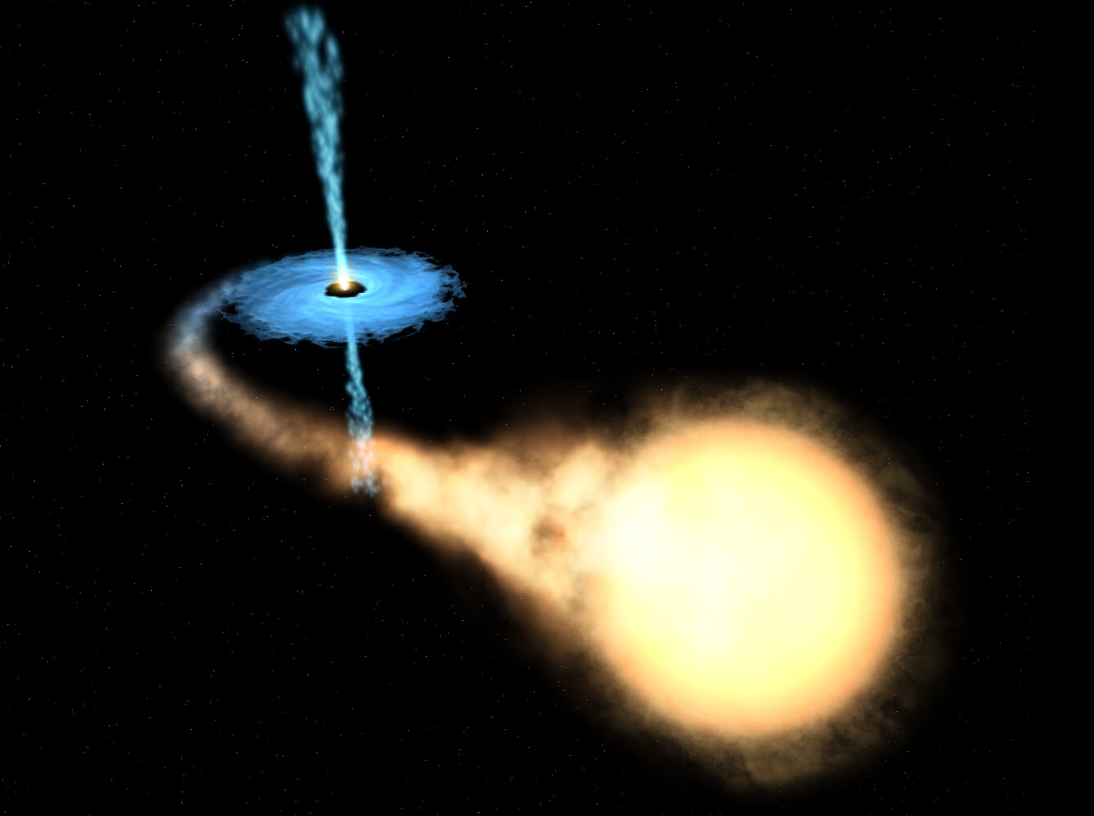
Master Thesis
Site: Merate (LC)
Duration
1 year
Tutor
Sara Motta
Contact
sara.motta AT inaf.it
Description
Background – X-ray binaries:
Throughout the Universe the combination of a deep potential well and an accretion disc, (which forms when matter is gravitationally captured by a celestial body) leads to the generation of fast, collimated outflows called jets.
This process, still poorly understood, occurs in proto-planetary discs and at the centre of galaxies alike, but around black hole (BHs) and neutron stars (NSs) it is taken to the extreme.
In a process known as feedback these so-called compact objects contrive to feed back to the surrounding space a large fraction of the energy and matter they could have swallowed, thereby acting to heat their environment rather than behaving only as sinks.
Feedback is important across a range of scales: from stellar-mass BHs and NSs in X-ray binaries (XRBs), to super-massive BHs powering the AGN, which via this process regulated the growth of massive galaxies.
The AGN and XRBs hosting BHs and NSs provide us with the best tests of General Relativity, but while the former evolve over decades to millenia, XRBs evolve rapidly, offering us the opportunity to probe on humanly accessible time-scales the energy and matter input/output around accreting objects.
The knowledge gained from studying XRBs can then be directly applied to AGN, where the inflow/outflow processes follow the same basic principles as around stellar-mass BHs.
Using observations from across the entire electromagnetic spectrum, and employing various techniques best-suited to extract the information stored in the data we investigate the physics of the accretion and outflow generation processes in X-ray binaries, with the aim of understanding the nature of such processes and the link between them both on stellar-mass scales, and on super-massive scales.
The Thesis – In the theory of General Relativity (GR), the frequencies that characterize the motion of matter close to a rotating compact object (a neutron star or a black hole) can differ substantially from the classical frequencie in Newtonian gravity. GR predicts the existence of three different orbital frequencies: the relativistic Keplerian orbital frequency (in the azimuthal direction) and the related epicyclic frequencies: the vertical and radial epicyclic frequency (the so-called epicyclic frequencie).
GR predicts that the motion of matter in the immediate surroundings of black holes (BHs) carries the signature of yet untested strong-field gravity effects which are amongst the fundamental consequences of Einstein’s theory.
Quasi-periodic oscillations (QPOs) are commonly observed in the X-ray light curves of stellar-mass accreting compact objects. QPOs are the result of almost periodic fluctuations of the amount of light arising from an astronomical source and are detected and studied mainly through the analysis of a power density spectrum (PDS), produced via the Fourier analysis of the signal. QPOs are not coherent signals and in a PDS take the form of relatively narrow peaks with a characteristic centroid frequency measurable with high precision and a finite width. Different QPO types have been observed so far over a wide range of frequencies (from a tenth to several hundreds Hz) and in some cases multiple QPOs are seen simultaneously in the PDS of accreting sources.
The relativistic-precession mode (RPM) associates three types of QPOs observable in the PDS of accreting black hole binaries with a combination of the Keplerian frequency and the epicyclic frequencies. The nodal precession frequency or Lense-Thirring frequen (= Keplerian frequency – vertical epicyclic frequency) is associated with oscillations usually observed at low (0.1-20 Hz) frequencies, while the periastron precession (= Keplerian frequency – radial epicyclic frequency) and the Keplerian frequency are associated to two different types of high-frequency (30-450 Hz) QPOs, known as “lower” and “upper” high-frequency QPO (HFQPO) respectively. The analytical form of the keplerian, periastron precession, and nodal frequency only depend on three parameters: the mass and the spin of the black hole, and the radius at which the QPOs are generated. In 2014 the RPM was used to establish a successful method to self-consistently estimate the mass and the spin of a BH based only on the detection of QPOs.
Since high frequency QPOs are rare in black holes, the RPM has been so far used only to estimate the mass and spin of the black hole in three systems. Neutron stars, instead, commonly show the three types of QPOs that are relevant for the RPM, and hence they offer the unique opportunity to test this model on a large sample of systems. So far only two neuron star XRBs have been tested.
The aim of this thesis is to perform a detailed test of the RPM on a famous NS system, Sco X-1, which is an important source for a number of reasons. besides being relatively nearby, this is the primary target for the search of continuous gravitational waves. Thus, measuring the spin of the neutron star will have a high impact in field of the gravitational wave astronomy. We will analyze the QPOs observed in Sco X-1 and we will attempt the first timing-based estimate of the spin of this source using the RPM. We will make an assessment of the validity of the RPM for the study of neutron stars, and we will test a version of the model specifically developed to describe the complex space time near the surface of a neutron star. Our results will be compared with the current understanding of neutron star X-ray binaries and their variability. This work will deliver important insights into the properties of neutron stars, which will be relevant in a broad context.
[Credit image:Wikipedia]